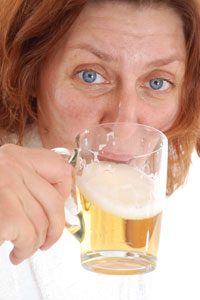According to a recent report, Wisconsin’s binge-drinking problem is costing the state somewhere around $7 billion a year. Surveys show that Wisconsin residents binge drink at a rate of around 25 percent, which is the highest in the nation.
The survey considers having five or more drinks in a sitting as a binge. But the average Wisconsin resident ups the ante and binge drinks on an average of nine beverages per sitting.
 A good chunk of the cost to the state, which is $6.8 billion total, comes in the form of lost worker productivity, which accounts for more than one-third of that total. Vehicle accidents, health care costs and court costs make up around another third of the total.
A good chunk of the cost to the state, which is $6.8 billion total, comes in the form of lost worker productivity, which accounts for more than one-third of that total. Vehicle accidents, health care costs and court costs make up around another third of the total.
Despite the prevalence of this drinking, the state only generated less than $70 million in taxes on booze, which barely makes up for one percent of the burden that booze puts on the state. Given the popularity of alcohol in the state, voters aren’t going to raise taxes on the product, either. The tax hasn’t changed since the late 1960s.
To break it down into what alcohol abuse is costing each individual resident, experts have put the tab at $1,200 per capita. That includes children. In 2011, it is reported that more than 1,500 residents died in alcohol-related incidents. About 48,000 were hospitalized and another 60,000 were arrested under the influence.
15 Mar 2013
Naltrexone Treatment for Amphetamine Addiction
Naltrexone is a medication originally designed to help recovering opioid addicts maintain drug abstinence during treatment. Substance abuse specialists and researchers eventually discovered that use of the medication can also help reduce alcohol cravings in recovering alcoholics. According to the results of recent studies, naltrexone also holds promise as a potential treatment for people recovering from amphetamine addiction. This news has significant real-world importance, because doctors currently have no medication options to offer to their amphetamine-addicted patients. Discovery of such a medication could potentially help vast numbers of people throughout the world successfully break the cycle of active amphetamine abuse.
Read More
11 Mar 2013
Substance Withdrawal Delirium
Substance withdrawal delirium is a mental health condition that occurs when diminishing levels of alcohol, drugs, or medications in the body lead to the onset of an incoherent, unbalanced state of mind. Along with a related condition called substance intoxication delirium, it belongs to a group of disorders that also includes various forms of dementia and amnesia. While a variety of substances can potentially produce delirium during the withdrawal process, alcohol has an especially well-deserved reputation for its delirium-inducing potential. Alcohol withdrawal-related delirium, known as delirium tremens, is a potentially fatal condition.
Read More
06 Mar 2013
Alcoholism’s Effects in Women
Alcoholism is the classic term for patterns of alcohol abuse that result from a chemical dependence on alcohol’s presence in the body. Along with other abusive patterns of alcohol use, it belongs to a group of conditions known as alcohol use disorders (AUDs). Both men and women can develop a number of serious short- and long-term health complications as a consequence of alcoholism. However, while men become alcoholics more frequently than women, women alcoholics have higher risks than men for developing certain alcoholism-related health problems. In addition, female alcoholics die prematurely much more frequently than male alcoholics.
 The Basics
The Basics
For any given level of intake, women have a greater sensitivity to alcohol’s effects than men. Three physical factors help explain this phenomenon. First, relative to overall size and weight, women’s bodies contain less water than men’s bodies. This is relevant because water dilutes alcohol; therefore, in an environment that contains relatively little water, alcohol remain relatively undiluted and produces intensified effects. Second, compared to men’s bodies, women’s bodies apparently have less active forms of an enzyme called alcohol dehydrogenase, which plays a key role in breaking alcohol down and rendering it harmless; in real-world terms, reduced alcohol dehydrogenase activity translates into higher levels of alcohol lingering in the bloodstream. In addition, some women may be more susceptible to alcohol’s effects during certain phases of their menstrual cycles.
Because of their relative susceptibility to alcohol’s effects, women have a lower recommended maximum daily/weekly alcohol intake than men, the National Institute on Alcohol Abuse and Alcoholism explains. On any given day, the average woman can safely drink as much as a single drink of beer, wine, or hard liquor (the specific size of a standard drink varies according to the type of alcohol under consideration). In any given week, the average woman can safely consume as many as seven total drinks. By comparison, the average man under the age of 65 can safely consume two drinks a day and 14 drinks per week. For a variety of reasons not directly related to alcoholism, men over the age of 65 need to follow the same alcohol consumption guidelines as women.
The Consequences of Alcoholism
As indicated previously, women abuse alcohol and/or develop alcoholism less frequently than men. In fact, women account for only roughly one-third of all of the alcoholics in the United States. However, female alcoholics sometimes experience more severely negative health outcomes than male alcoholics. For instance, according to the Centers for Disease Control and Prevention, alcoholic women have higher chances of developing cirrhosis (scarring of the liver) and other alcohol-related liver disorders than their male counterparts. Compared to alcoholic men, alcoholic women also have higher risks for the onset of damage in the tissues that form the heart muscle; these heightened risks extend to women who abuse alcohol but don’t have all of the hallmarks of alcoholism. In addition, current research suggests that women alcoholics have relatively high chances of developing alcohol-related memory problems and physical shrinkage of their overall brain size. Women also apparently develop these problems more quickly than men.
In comparison to other women, women alcoholics have relatively high chances of developing certain forms of cancer, including cancers of the breast, colon, throat, liver, mouth, and esophagus. In the case of breast cancer, alcoholic women’s risks go up as their rate of alcohol consumption increases. Apart from disease-related risks, alcoholic women have increased risks for exposure to rape and other forms of sexual assault. These assault-related risks extend to women who participate in a form of alcohol abuse called binge drinking, which involves consuming enough alcohol within a two-hour timeframe to become legally intoxicated; most women reach a legally intoxicated state (marked by a blood alcohol content equal to or in excess of 0.08 percent) when they consume four or more drinks within this span of time.
Fatal Consequences
When considered together, men and women alcoholics between the ages of 18 and 64 die an average of 20 years sooner than people without alcohol dependencies, according to the result of a 14-year study published in published in 2012 in the journal Alcoholism: Clinical & Experimental Research. However, when the two genders are considered separately, women alcoholics in this age range die twice as often as alcoholic men. Compared to the general population, alcoholic women between the ages of 18 and 64 die more than four times as frequently. The authors of the study note that their results may somewhat overestimate women alcoholics’ risks for fatal outcomes, but believe any overestimation (if it exists) is in terms of specific percentages rather than the basic results of their research.
Alcohol withdrawal is a condition that occurs when a long-term, heavy drinker stops using alcohol. It inevitably appears in alcoholics who decide to stop drinking and seek alcohol addiction treatment. Depending on factors that include the length of alcohol use and the intensity of alcohol use, the symptoms of withdrawal can range from relatively mild to severe or even life-threatening. Unfortunately, fear of these symptoms can play a significant role in continued drinking and the avoidance of treatment. However, in the vast majority of cases, alcohol withdrawal produces more or less predictable changes in the body, and proper monitoring and medical treatment can help a recovering drinker make it through this process.
Read More
Not everyone who battles alcoholism appears to be an alcoholic. High functioning alcoholics may give the illusion that they have it all together – they can usually hold down a job and are able to go about their everyday lives while continuing to consume alcohol on the side. But because they are able to be a productive member of society, many in this category struggle to admit they have a problem.
Lindsay Lohan has been touted as a functioning alcoholic, but the troubled actress has certainly had her share of problems. Headlines detailing delinquent behavior and substance abuse seem to follow her wherever she goes. The latest drama places her at a nightclub drinking till the wee hours of the morning – an episode that ended in assault charges for allegedly throwing a punch at another woman, psychic, Tiffany Ava Mitchell. She also faces several charges for a car accident that occurred last June.
Characteristics Of A Functioning Alcoholic
In her book, “Understanding the High Functioning Alcoholic,” Sarah Allen Benton, a licensed health counselor, describes some of the characteristics of a functioning alcoholic:
- Drinking even in the face of negative consequences
- Devoting considerable time to drinking
- Denial about one’s condition
- Consuming alcohol in a dangerous manner such as while driving
One look at Lohan’s record and it becomes apparent that she checks all the boxes. The actress has faced a number of altercations with the law associated with substance abuse including involvement in a high speed car chase, driving under the influence, driving without a valid license, and possession of cocaine. And despite the threat of jail time, the actress refuses to give up her partying ways. Sources claim that she downs two large bottles of vodka each day.
But Lohan is not alone; according to an article found at AllVoices.com, of the 12 million people living in this country classified as alcoholics, up to a third are considered high functioning. Over time, heavy drinking can lead to heart problems, cancer, nerve damage, and liver disease.
29 Oct 2011
The High Cost of Alcohol Abuse in the U.S.
The cost of alcohol abuse in families is high. Broken marriages, physical abuse, emotional instability, health problems and unemployment are all possible consequences of the excessive abuse of alcohol.
Read More
Heavy drinking during college is a popular pastime. Many parents worry when they suspect that their college freshman is participating in the college party scene, but in many cases, the students phase out of the party life as they exit college and take on adult responsibilities.


